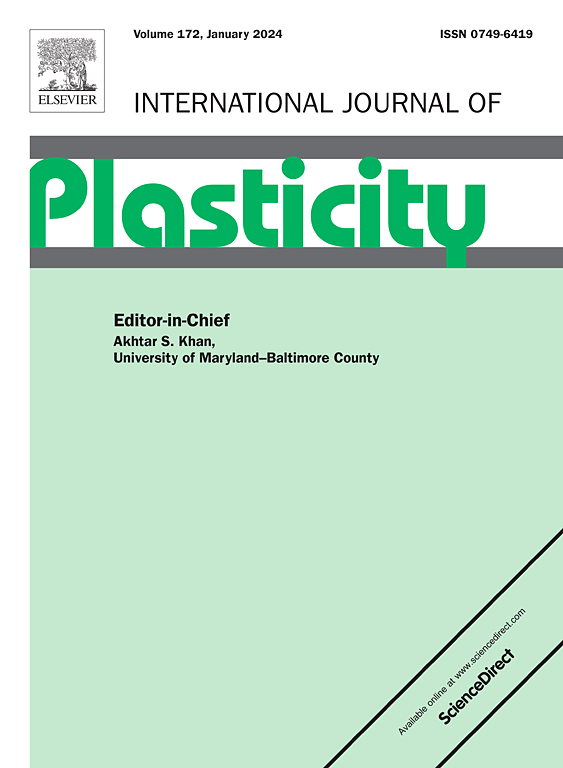Strain localization induced by closely spaced lamellae structure in a Mg alloy containing long period stacking ordered structure
IF 12.8
1区 材料科学
Q1 ENGINEERING, MECHANICAL
引用次数: 0
Abstract
The Mg alloys containing the long period stacking ordered (LPSO) phase are a major research focus for their desirable mechanical properties, yet the role of the LPSO phase in the form of intragranular lamellae in tensile ductility has been elusive. Here, we investigate strain localization induced by LPSO lamellae in a Mg-Gd-Y-Zn-Zr alloy using correlated microstructure characterization, high-resolution full-field strain measurements and crystal plasticity simulations. The aged alloy containing lamellae exhibits reduced ductility due to intragranular microcracks along basal planes, contrasting with grain boundary cracks in the lamellae-free counterpart. Heaviside-digital image correlation (DIC) analyses reveal that the lamellar structure intensifies basal slip activity, leading to enhanced strain localization compared to the same magnesium alloy without this structural feature. Site-specific characterizations aided by atomic force microscopy (AFM) and transmission electron microscopy (TEM) identified that severe slip steps occur in the Mg matrix between closely spaced lamellae. Parameterized crystal plasticity simulations further revealed that the strain localization on the basal plane originates from the elevated local stress that is raised by the adjacent lamellae of high stiffness, and is exacerbated by high lamellae thickness-to-spacing ratios or volume fractions. Moreover, the promotion of the easy basal slip and suppression of the hard yet desired non-basal slip by lamellae make the deformation mode more restrictive, which is against the requirement for homogeneous deformation. These findings elucidate the potential detrimental effect of lamellae on ductility, thereby providing valuable insights for future design of Mg alloys containing LPSO phases.


含长周期堆积有序结构的镁合金中紧密片层结构引起的应变局部化
含长周期有序堆积相(LPSO)的镁合金因其优异的力学性能而成为镁合金研究的热点,然而,以晶内片层形式存在的LPSO相在镁合金拉伸延展性中的作用一直是未知的。在这里,我们利用相关的显微组织表征、高分辨率的全场应变测量和晶体塑性模拟研究了LPSO片层在Mg-Gd-Y-Zn-Zr合金中引起的应变局部化。与不含片层的时效合金的晶界裂纹相比,含片层的时效合金由于沿基面存在晶内微裂纹而表现出塑性降低。heaviside -数字图像相关(DIC)分析表明,与没有这种结构特征的镁合金相比,片层结构增强了基底滑移活动,导致应变局部化增强。原子力显微镜(AFM)和透射电子显微镜(TEM)辅助的位点特异性表征发现,在紧密间隔的片层之间的Mg基体中发生了严重的滑移步骤。参数化晶体塑性模拟进一步表明,基面上的应变局部化源于相邻高刚度片层引起的局部应力升高,而高片层厚度与间距比或体积分数加剧了应力局部化。此外,片层对易基底滑移的促进和对硬非基底滑移的抑制使变形模式更具限制性,这与均匀变形的要求相违背。这些发现阐明了薄片对延展性的潜在不利影响,从而为未来设计含LPSO相的镁合金提供了有价值的见解。
本文章由计算机程序翻译,如有差异,请以英文原文为准。
求助全文
约1分钟内获得全文
求助全文
来源期刊

International Journal of Plasticity
工程技术-材料科学:综合
CiteScore
15.30
自引率
26.50%
发文量
256
审稿时长
46 days
期刊介绍:
International Journal of Plasticity aims to present original research encompassing all facets of plastic deformation, damage, and fracture behavior in both isotropic and anisotropic solids. This includes exploring the thermodynamics of plasticity and fracture, continuum theory, and macroscopic as well as microscopic phenomena.
Topics of interest span the plastic behavior of single crystals and polycrystalline metals, ceramics, rocks, soils, composites, nanocrystalline and microelectronics materials, shape memory alloys, ferroelectric ceramics, thin films, and polymers. Additionally, the journal covers plasticity aspects of failure and fracture mechanics. Contributions involving significant experimental, numerical, or theoretical advancements that enhance the understanding of the plastic behavior of solids are particularly valued. Papers addressing the modeling of finite nonlinear elastic deformation, bearing similarities to the modeling of plastic deformation, are also welcomed.
 求助内容:
求助内容: 应助结果提醒方式:
应助结果提醒方式:


